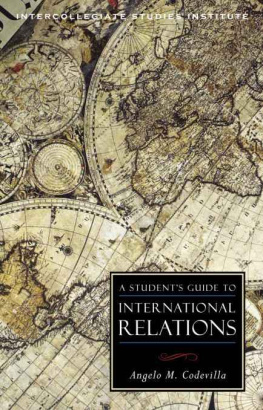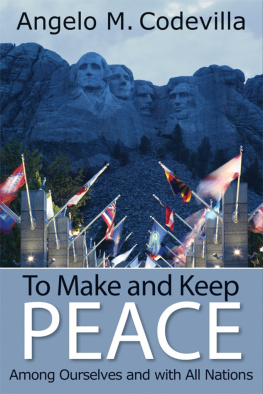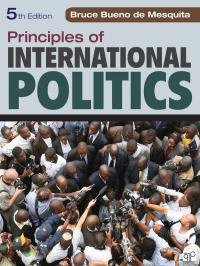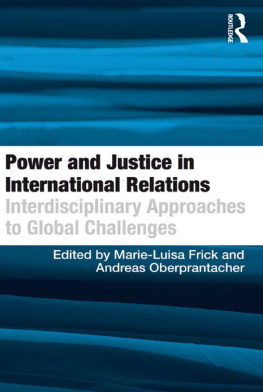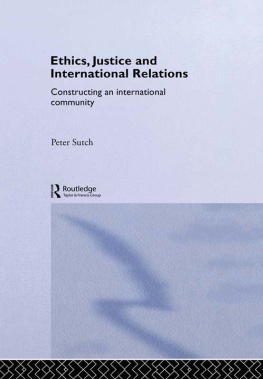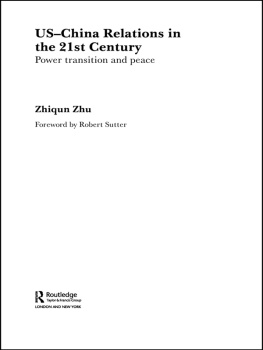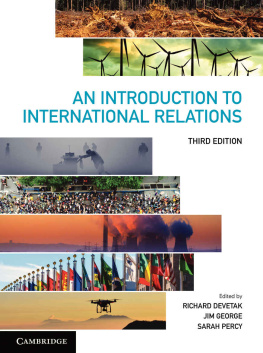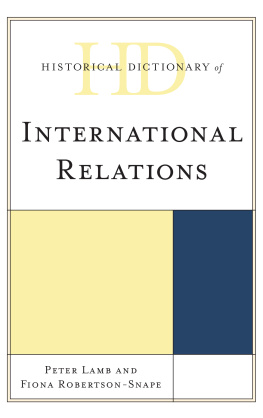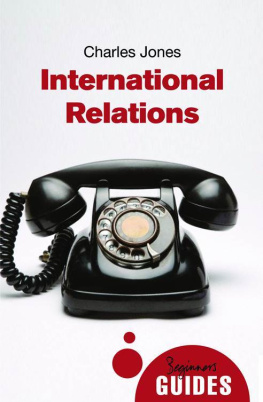THE PRESTON A. WELLS JR. GUIDES TO THE MAJOR DISCIPLINES

P HILOSOPHY Ralph M. McInerny
L ITERATURE R. V. Young
L IBERAL L EARNING James V. Schall, S.J.
T HE S TUDY OF H ISTORY John Lukacs
T HE C ORE C URRICULUM Mark C. Henrie
U . S . H ISTORY Wilfred M. McClay
E CONOMICS Paul Heyne
P OLITICAL P HILOSOPHY Harvey C. Mansfield
P SYCHOLOGY Daniel N. Robinson
C LASSICS Bruce S. Thornton
A MERICAN P OLITICAL T HOUGHT George W. Carey
R ELIGIOUS S TUDIES D. G. Hart
T HE S TUDY OF L AW Gerard V. Bradley
N ATURAL S CIENCE Stephen M. Barr
M USIC H ISTORY R. J. Stove
A Studentss Guide to International Relations
ANGELO M. CODEVILLA

A Students Guide to International Relations is made possible by grants from the Lee and Ramona Bass Foundation, the Huston Foundation, the Lillian S. Wells Foundation, the Barre Seid Foundation, and the Grover Hermann Foundation. The Intercollegiate Studies Institute gratefully acknowledges their support.
Copyright 2010 by Angelo M. Codevilla
All rights reserved. No part of this publication may be reproduced or transmitted in any form or by any means, electronic or mechanical, including photocopy, or any information storage and retrieval system now known or to be invented, without permission in writing from the publisher, except by a reviewer who wishes to quote brief passages in connection with a review written for inclusion in a magazine, newspaper, broadcast, or online publication.
Codevilla, Angelo, 1943
A students guide to international relations / Angelo M. Codevilla.
p. cm. (Student guides to the major disciplines)
ISBN 978-1-610170-30-7 (electronic)
1. International relations. I. Title.
JZ1242.C632 2010
327dc22 2010020118
ISI Books
3901 Centerville Road
Wilmington, DE 19807-1938
www.isibooks.org
Design by Sam Torode
Manufactured in the United States of America
CONTENTS

INTRODUCTION

The number of students majoring in international relations (IR) today dwarfs that of a generation ago. But whereas a student who majors in mathematics or even economics can expect a more or less uniform curriculum regardless of the university or the professor, students of IR will find the field defined differently at different institutions and by different professors. This guide points the student toward what is essential in the field and to the books most likely to help one make sense of a complex world.
W HAT I S IR ?
The art by which governments and peoples deal with one another goes by many names: diplomacy, statecraft, foreign affairs, foreign relations. Formal education does not define this art. Rather, statesmen have defined it by practicing it. Whoever practices it successfully must have in mind an accurate picture of his own countrys character, needs, objectives, and capacities, as well as those of foreign countries. Knowledge of the techniques of international intercourse is helpful. The history of past events also illuminates current choices. These things can be learned from books to a considerable extent.
In American higher education, IR is a term that covers courses in American foreign policy, area studies, IR theory, international institutions, peace studies, conflict resolution, and game theory, as well as courses in what was once the whole field, namely, diplomatic history. Such courses may be offered by political science departments (IR is one of political sciences four traditional subdisciplines), by departments of IR, or in any of the thirty-five professional schools of international affairs, such as Tufts Universitys Fletcher School of Law and Diplomacy or John Hopkinss School of Advanced International Studies. Students may reach the Ph.D. via any of these paths.
Students typically focus on one or more of IRs many aspects, such as U.S. foreign policy or the study of a specific region, and they usually combine IR with another field, such as economics or even public health. Many are simply interested in learning what lies behind the headlines about the big events on the international scene.
These events are well worth understanding because nations are born and die through relations with one another. The United States independence became possible because of a complex struggle between Britain, France, and Spain. Greek, rather than Persian, civilization is our heritage because the Athenians defeated King Xerxes navy at Salamis in 480 B.C. Our civilization is Christian rather than Islamic because Charles Martel marshaled Frankish tribes to stop the Muslim invasion of Europe at the Battle of Tours in A.D. 732. The history of international affairs is the record of peoples who have shown the best and the worst of which human beings are capable. As Charles Hill illustrates in Grand Strategies: Literature, Statecraft, and World Order (2010), international affairs has been the subject of some of the worlds great literature.
American authors and teachers today tend to reflect the schools of thought about foreign affairs that have developed here since the early twentieth century in the course of American political struggles. These schools differ radically from how Americans approached the world from the Founding until circa 1900, as well as from how foreign affairs have classically been taught.
N EW A MERICA, O LD W ORLD
Americas Founders drew their guidance in international affairs from historys store of wisdom and folly. Plutarchs Lives was Alexander Hamiltons favorite authority. In Latin and Greek, the Founders absorbed Thucydides account of classical Greeces self-destructive diplomacy, Livys tale of Romes rise through conquest, and Tacituss account of the early emperors attempts to rule the known world. Most had read Machiavelli, and all were avid followers of the struggles between Europes eighteenth-century sovereigns. Remarkably, the Founders agreed that Americas relations with the rest of the world should bear as little resemblance as possible to those of Athens, Sparta, Rome, Paris, or London. As heirs to the British Whig tradition expressed in Viscount Bolingbrokes Patriot King (1738), and in accord with the new understanding of economics being elaborated by the French Encyclopedist Turgot (1750) and the Scottish moral philosopher Adam Smith (1776), they believed that the statesmans primary duty was to avoid needless war. Their proximate objective was to minimize foreign interference in the American peoples unique character and independent development.
George Washingtons 1796 Farewell Address had encapsulated their generations foreign policy. Secretary of State John Quincy Adams, in his July 4, 1821, address to the U.S. House of Representatives as well as in the documents associated with the Monroe Doctrine of 1823, explained the policy: Peaceful commerce with all nations, and good wishes to all regardless of their governance or culture. To avoid foreign interference in our affairs, Americans would mind their own domestic business. In Adamss words, America goes not abroad in search of monsters to destroy. She is the well-wisher to the freedom and independence of all, but the champion and vindicator only of her own. Bordering states, nearby islands, and then the oceans would concern Americain that order. The rest of the world would matter insofar as it affected these. What is nearest is dearest.
The U.S. government neither could nor would interfere with Americans pouring into the nearly empty lands between the Mississippi and the Pacific. When this flood of settlers brought war with Mexico, some Americans wanted the U.S. government to take more than that countrys empty lands, while others, including Adams, objected to allowing even the independent Texans to join the union, in part because they feared it would compromise Americas domestic character and bring war between the unions slave and free states. During and after the Civil War (186165), American foreign policy was under the direction of Abraham Lincolns secretary of state, William Seward, who pursued Adamss vision of Americas greatness by rolling back Frances claims on Mexico and Britains claims on any canal that might be dug across central America, as well as by encouraging immigration and peaceful expansion (e.g., the Alaska purchase, 1867). The next major figure in U.S. foreign policy, Secretary of State James G. Blaine (1881, 188992), did his best to follow in Sewards and Adamss footsteps. Not until the Spanish-American War of 1898 did any major American figure suggest that the Founders pursuit of the national interest through mutual noninterference might be flawed.
Next page
